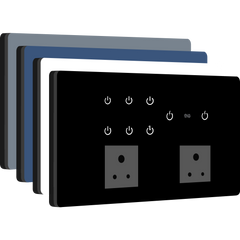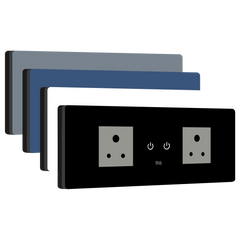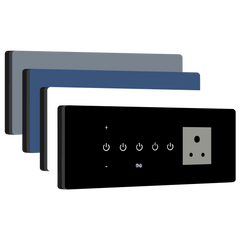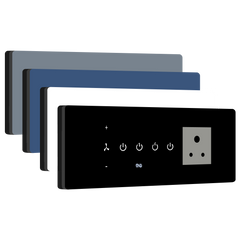Mesh Networking: Enhancing Connectivity and Range for Smart Homes

1. Definition
Mesh networking is a type of network topology that enables devices to communicate with one another through a decentralized, multi-point system. In the context of smart homes, mesh networking allows smart switches and other connected devices to extend their range and improve connectivity by forming a network where each device acts as a node that relays data to other devices. This setup ensures a more stable and consistent connection throughout your home, even in areas that would typically suffer from weak Wi-Fi signals.
2. Key Takeaways
- Mesh networking allows smart devices to communicate with each other directly, reducing dependency on a single central hub or router.
- It ensures a stable connection by using multiple devices to relay data, improving the coverage area and performance of your smart home network.
- Unlike traditional networks, where data has to travel from the device to the router and back, mesh networking enables devices to connect with the nearest node, reducing latency.
- Mesh networking is particularly beneficial for large homes or buildings with many obstacles that can block Wi-Fi signals.
- It can increase the reliability of your smart switches by reducing connection drops and ensuring a seamless experience for users.
3. Why Mesh Networking Is Important
-
Increased Coverage Area
In traditional Wi-Fi networks, the signal strength decreases as you move farther from the router, especially in larger homes or buildings with thick walls and obstructions. Mesh networking solves this problem by using multiple nodes (smart devices or dedicated mesh routers) that communicate with each other, effectively extending the network coverage. This is ideal for large homes or homes with multiple floors, as it ensures that your Iotics Smart Switches maintain a strong connection no matter where they are installed. -
Better Performance and Reliability
Mesh networks are designed to automatically route data through the most efficient path, so if one node is busy or experiencing interference, data can be sent via another path. This feature reduces the chances of signal dropouts, slow speeds, or dead spots. For Iotics Smart Switches, this means more reliable remote control and seamless operation, as the devices will stay connected to the network without interruptions, providing a better overall user experience. -
Scalability
Mesh networks are highly scalable. If you want to add more Iotics Smart Switches or other smart home devices in the future, you can easily expand the network by adding additional nodes. This scalability is particularly useful as your smart home ecosystem grows, ensuring that your network can keep up with the increasing number of connected devices. -
Reduced Latency
In a mesh network, devices can communicate directly with each other instead of having to route all data through a single central hub. This decentralized communication reduces latency, or the delay between issuing a command (such as turning on a light) and the device responding. For Iotics Smart Switches, this means quicker response times when you use the app or voice control, creating a smoother, more immediate interaction with your devices. -
Improved Wi-Fi Efficiency
Mesh networks use dual-band or tri-band technology to spread the Wi-Fi load across different channels, reducing congestion on any single channel. This improves the overall efficiency of the network, especially in households with multiple devices. For smart homes with a large number of smart devices, mesh networking ensures that every device, including Iotics Smart Switches, gets sufficient bandwidth and maintains optimal performance.
4. Example/Use Case
Imagine a family living in a large two-story home. On the second floor, the smart lights, thermostats, and Iotics Smart Switches are all controlled via a mobile app. However, the Wi-Fi signal from the main router on the first floor does not reach the second floor very well, causing delays or connection failures when trying to control the devices.
By installing a mesh networking system, the home is equipped with additional mesh nodes placed strategically throughout the house. These nodes work together to create a unified and seamless network. As a result, the Iotics Smart Switches on the second floor stay connected and responsive, with no more signal drops or delays when using the app to adjust the lights or schedule the thermostat. The system’s extended coverage ensures that the entire home benefits from a strong and reliable connection.
5. Frequently Asked Questions (FAQs)
-
How does mesh networking work in a smart home?
In a smart home, mesh networking works by having multiple devices (such as Iotics Smart Switches) communicate with each other rather than relying solely on one central router. Each device acts as a node that forwards data, ensuring reliable connectivity and broad coverage. -
Do I need a mesh network for my smart home?
Mesh networking is particularly beneficial for large homes or homes with connectivity issues, such as dead spots or slow Wi-Fi speeds. If your smart home is experiencing connection drops or slow response times with Iotics Smart Switches, implementing a mesh network can significantly improve performance. -
Is mesh networking expensive?
Mesh networking systems can be an investment, but they are typically cost-effective when compared to the frustration of dealing with poor connectivity or signal issues in a large home. Additionally, the long-term benefits in terms of coverage, performance, and reliability often outweigh the initial cost. -
Can I use a mesh network with any smart switch?
Yes, most smart switches, including Iotics Smart Switches, are compatible with mesh networking systems. As long as your smart devices are connected to the network, the mesh system will help ensure they stay connected and perform well. -
What are the differences between mesh networks and traditional Wi-Fi networks?
Traditional Wi-Fi networks rely on a single router to distribute the signal, which can lead to weak connections or dead spots in larger areas. Mesh networks, on the other hand, use multiple nodes to relay data, providing more reliable and consistent coverage across the entire home.
Improve the connectivity and reliability of your smart home today with Iotics Smart Switches, designed to work seamlessly with mesh networking systems. Explore Our Range of Smart Switches Now.
7. Related Terms
- Dual-Band WiFi
- WiFi 6 Support
- Bluetooth Connectivity
- Home Automation










